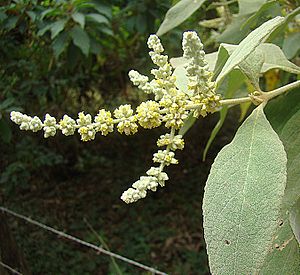Buddleja americana facts for kids
Buddleja americana is a type of plant that grows as a shrub. It's the most common Buddleja species found in the Americas. You can find it all the way from Tamaulipas, Mexico, through Central America and many islands in the West Indies. It also grows in South America, reaching as far east as Venezuela, west to the Galapagos Islands, and south to Bolivia. This plant can grow from sea level up to 2,500 meters high. It lives in many different places, like cloud forests, mountain savannas, pine and oak forests, and rocky areas near rivers. You might also see it growing in fields and along roadsides.
This plant was first named and described by a famous scientist named Carl Linnaeus in 1753.
Quick facts for kids Buddleja americana |
|
|---|---|
 |
|
| Buddleja americana | |
| Conservation status | |
| Scientific classification | |
| Genus: |
Buddleja
|
| Species: |
americana
|
| Synonyms | |
What it Looks Like
B. americana is a shrub that usually grows between 2 and 5 meters (about 6 to 16 feet) tall. It has light brown bark that often has cracks in it. The younger branches are somewhat square-shaped and covered in soft hairs. Its leaves can be very different in size, shape, and how hairy they are.
The flowers grow in clusters that are 5 to 25 centimeters (about 2 to 10 inches) long. These clusters can have one or two levels of smaller branches. The individual flowers are small, with yellow insides and white outsides. The part of the flower that looks like a tube (called the corolla) is usually less than 2.5 millimeters long.
Unlike many other Buddleja species from the Americas, which often have two sets of chromosomes (called diploid), B. americana has four sets of chromosomes (called tetraploid). This means it has 76 chromosomes in total.
Growing the Plant
This plant doesn't like cold weather at all. Even temperatures just a little below freezing can quickly kill it. If you're thinking about growing it, it's best for warmer climates. In the USDA plant hardiness zones, it can only survive in zone 9 or warmer.
See also
 In Spanish: Tepozan para niños
In Spanish: Tepozan para niños


